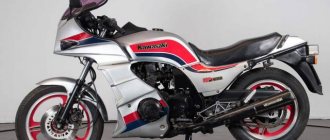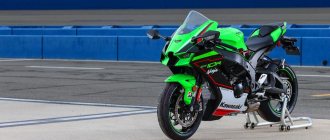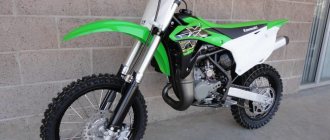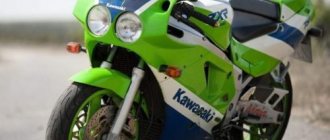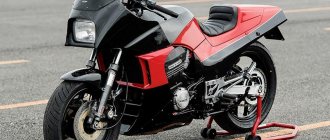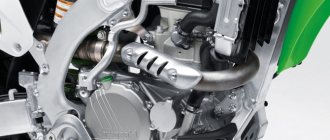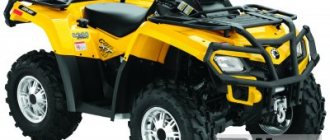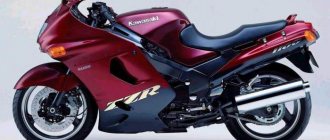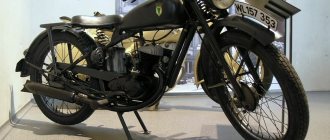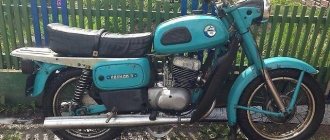| Kawasaki Zephyr 750 (1991-2006) | Kawasaki Zephyr 750 RS (1996-2002) |
Model of the classic Kawasaki Zephyr 750
first appeared in 1991. It was based on an in-line 4-cylinder engine from the sports version of the Kawasaki GPZ750, which was air-cooled and had 2 valves per cylinder. Despite the archaic nature of the Kawasaki Zephyr 750, it was produced for almost 17 years and was officially discontinued only in 2006.
Among the features of the motorcycle, it is worth noting a classic steel duplex frame, a round headlight, a simple telescopic fork at the front and a double shock absorber at the rear. The Kawasaki Zephyr 750 engine does not have outstanding technical characteristics and produces only 72 hp. power, maximum torque (59 Nm) is available already at 7500 rpm.
In 1999, as a successor to the Kawasaki Zephyr 750, a more modern Kawasaki ZR-7 model appeared on the market, which had the same old air 8-valve engine (albeit slightly modified). The Kawasaki Zephyr 750 model continued to be produced in parallel until 2006.
Main modifications:
- Kawasaki Zephyr 750
is the regular version of the motorcycle. - Kawasaki Zephyr 750 RS
- version with classic spoked wheels.
Model range of the Kawasaki Zephyr series:
- Kawasaki Zephyr 400
- Kawasaki Zephyr 550
- Kawasaki Zephyr 750
- Kawasaki Zephyr 1100
The main competitors of the Kawasaki Zephyr 750 in the class:
- Honda CB 750
- Suzuki GSX750 Inazuma
Appearance
The Kawasaki Zephyr 1100 looks as it should - average. Alloy wheels do not look like sports wheels, nor do they look like cruiser wheels. The mirrors, although tall, do not pretend to be some kind of retro-classic in shape.
The interior of the bike is relatively open, but not too much, which, again, does not allow us to see a hint of retro classics in it.
It visually looks longer than a sports bike, shorter than a sports touring or cruiser. The landing is neither high nor low. There is enough space for a passenger, although this is not to say that this is the most suitable model for traveling together.
A used bike and a new bike sometimes look the same if the owner takes good care of the bike. Moreover, this applies not only to models that were almost never used and stood somewhere for decorative purposes. Some bikes look great even after hundreds of thousands of kilometers.
Comfort
Of course, this equipment is convenient both to drive and to maintain. It is easy to get consumables and spare parts for the motorcycle. It is convenient to move in traffic, in a slow-moving traffic jam and on a spacious country road. And all because this is a universal class of motorcycles.
Road bikes will probably be the most comfortable for most. They are more comfortable than a sports and motocross motorcycle, and even more comfortable than a cruiser. This particular model is distinguished by the quality of the seat and the clarity of the dashboard indicators. In addition, it is comfortable to place your feet, they do not get tired.
The motorcycle is suitable for a person of average height, as is clear from numerous videos and photos. It is possible to ride the bike with a passenger, although it is not the best choice for two. Simply because there is no insurance for the passenger in the back.
Considering how much this equipment costs, the decision to purchase one is rational. It’s possible to get such a bike for 125 thousand Russian rubles. Reviews and descriptions on websites often say that you can buy such a machine once and it will last for decades. However, this directly depends on the state of the technology.
Mellow Motorcycles
One would think that after Zephyr's successful sales, journalists would admit they were wrong. But this only happened with the widespread revival of retro motorcycles. Until then, the luxury heavyweights had attracted much more of the lightweight, off-road classic motorcycles. Not Flo Hubert, who founded Mellow Motorcycles to express his overwhelming passion for classic street bikes and cars.
Flo Hubert says:
Mellow Motorcycles opened at the beginning of 2021, but by then we were already known as creators of unique and creative customs that were proudly owned by collectors, celebrities, motorcycle companies and simply lovers of the mode of transport.
Specifications
If you need a bike with optimal parameters for almost all occasions, then this is the Kawasaki Zephyr 1100. The technical characteristics of this model allow you to feel comfortable both in an urban environment and in the countryside.
| Motor type | in-line, 4 stroke, 4 cylinders |
| Power | 86 hp |
| Torque | 83 Nm |
| Maximum speed | 199 km/h |
| Acceleration to 100 | 4 s |
| Fuel consumption per hundred | 6.1 l |
| Drive unit | chain |
| Transmission | five-speed |
| Frame | tubular steel |
| Rear suspension | pendulum, 2 shock absorbers, stroke 110 mm |
| Front suspension | telescopic fork, 43 mm, travel 130 mm |
| Rear brakes | 1 disc, 240 mm, two-piston caliper |
| Front brakes | 2 discs, 310 mm, two-piston calipers |
Thanks to a competent combination of filling elements, this model can be called one of the most balanced road classic motorcycles. Average handling, average speed, average level of comfort. Hence the average cost.
The Kawasaki Zephyr 750 is a real long-lived motorcycle. Having first gone on sale back in 1990, it gained such popularity that even when it was replaced by a new model, it was produced in parallel with it, until it was removed from the assembly line in 2007. Another name for this classic motorcycle is Kawasaki ZR-750 . Its successor was the Kawasaki ZR-7, produced since 1999. However, it was not for nothing that the Japanese continued to produce “Zephyr” with it, so beloved by many motorcyclists for its simplicity and reliability.
Throughout its production, the Zephyr 750 was produced without any changes. In creating this motorcycle, the designers were probably guided by the same principle that Honda engineers used when designing their Honda CB 750 - the simpler, the more reliable. This representative of the Kawasaki concern is made using technologies from the 80s, tested for decades. It is simple, even primitive, but extremely reliable and durable, and its resource is truly enormous. Not everyone, of course, likes such archaic motorcycles, but the ZR-750 has found its audience.
The basis for the Kawasaki Zephyr 750 was a simple steel frame, in which a derated engine from the Kawasaki GPZ 750 . The air-oil-cooled in-line four does not, of course, have stunning technical characteristics, but it regularly produces 71 hp. and 59 nM of torque, that is, comparable to the Kawasaki ER-6F still produced today, for example. Everything else is also simple - four carburetors, a chain, a five-speed gearbox. Nothing unusual. although the maximum speed for such a bike is impressive - more than 200 km/h.
Like the aforementioned Honda model, the Zephyr 750 not only looks like something from the distant past - it actually is, no matter what release date is on its paperwork. This is not just a retro styling, it is truly a motorcycle built using thirty-year-old technology, and in the best sense. Many motorcyclists are wary of modern motorcycles stuffed with electronics, and for them the ZR-750 would be an excellent choice.
Of course, this approach to design could not but affect other characteristics of the motorcycle, which turned out to be quite rigid and heavy. The dry weight of the Kawasaki Zephyr 750 is more than 200 kg, and the classic suspensions, rather short-travel, do not evoke any emotions, they just exist, that’s all. What else can you expect from such a bike? But the brakes turned out to be excellent, they are more than enough. The front wheel has two 300mm brake discs with two-piston calipers, and they stop the motorcycle very effectively.
There’s not much to say about the sharpness of control; after all, the design of the motorcycle also goes back to the 80s, so it’s best to avoid reckless maneuvers and crazy slalom between cars on the Zephyr 750. However, due to its small width, it can easily squeeze into the aisles, and the straight, classic fit does not tire your back, arms, or legs. A 17-liter gas tank is enough for approximately 250-270 kilometers of highway driving at a speed of 120 km/h.
The Kawasaki Zephyr 750 is suitable for those who value motorcycles, first of all, simplicity and the ability to repair them themselves, as they say, “on the knee.” Not everyone likes new, predatory-looking devices like the Yamaha MT-09, some like the good old classics, and the ZR-750 is its bright representative.
Similar articles:
- Kawasaki ZR-7 review
- Kawasaki ER-5 review
- Honda CB 650 review
- Suzuki GSX 1400 review
- Honda CL 400 review
- Kawasaki GTR 1000 Review
LiveJournal
History of changes
The car has not undergone many changes, but some things have changed:
- There were no changes from 1992 to 2002.
- In 2002, engine torque is reduced to 87 Nm and power to 91 hp. The dimensions of the fuel tank are reduced to 18 liters. Sensors are attached to carburetors that monitor the position of the throttles.
- In 2003, engine power was reduced again - to 83 Nm and 86 hp.
- In 2006, there were significantly fewer versions in the original colors.
Otherwise the bike has not changed. Yes, in principle, he didn’t need it, because tuning is primarily good for a sportbike or cruiser, but not for road motorcycles. They are simply not designed for this and will look, at least, strange.
Brief history of the model
- 1991 - start of production and sales of Kawasaki Zephyr 750.
Model
: Kawasaki Zephyr 750 (Japan, Europe, North America).
Factory designation
: ZR750-C1.
- 1992 - no significant changes.
Model
: Kawasaki Zephyr 750 (Japan, Europe, North America).
Factory designation
: ZR750-C2.
- 1993 - no significant changes.
Model
: Kawasaki Zephyr 750 (Japan, Europe, North America).
Factory designation
: ZR750-C3.
- 1994 - Model no longer available in North America.
Model
: Kawasaki Zephyr 750 (Japan, Europe).
Factory designation
: ZR750-C4.
- 1995 - no significant changes.
Model
: Kawasaki Zephyr 750 (Japan, Europe).
Factory designation
: ZR750-C5.
- 1996 - appearance of the RS modification with spoked wheels.
Model
: Kawasaki Zephyr 750 RS (Japan, Europe).
Factory designation
: ZR750-D1.
- 1997 - no significant changes.
Model
: Kawasaki Zephyr 750 RS (Europe).
Factory designation
: ZR750-D2.
- 1998 - no significant changes.
Model
: Kawasaki Zephyr 750 RS (Europe, Japan).
Factory designation
: ZR750-D3.
- 1999 - Model no longer available in the European market. Instead of the Zephyr, a new model was introduced - the Kawasaki ZR-7.
Model
: Kawasaki Zephyr 750, Kawasaki Zephyr 750 RS (Japan).
Factory designation
: ZR750-C6, ZR750-D4.
- 2001 - no significant changes.
Model
: Kawasaki Zephyr 750, Kawasaki Zephyr 750 RS (Japan).
Factory designation
: ZR750-C7, ZR750-D5.
- 2002 - no significant changes. Last year of production of the RS modification.
Model
: Kawasaki Zephyr 750, Kawasaki Zephyr 750 RS (Japan).
Factory designation
: ZR750-C8, ZR750-D6.
- 2003 - no significant changes.
Model
: Kawasaki Zephyr 750 (Japan).
Factory designation
: ZR750-C9.
- 2004 - no significant changes.
Model
: Kawasaki Zephyr 750 (Japan).
Factory designation
: ZR750-C10.
- 2005 - no significant changes.
Model
: Kawasaki Zephyr 750 (Japan).
Factory designation
: ZR750-C11.
- 2006 is the last year of production.
Model
: Kawasaki Zephyr 750 (Japan).
Factory designation
: ZR750C6F, ZR750C6FA, ZR750C6S, ZR750C6SA.
What do the owners say?
The Kawasaki Zephyr 1100 appeals to many because it is great for different situations. For example, one Muscovite writes that he periodically needs to travel to the region for work, and this bike is very convenient for this. The bike is also praised by simply fans of riding two-wheeled vehicles.
According to reviews from those who have ridden bikes of other classes before, there is no feeling of any tension here. The car is fast, but at the same time moderate. People who have experience driving both a sportbike and a cruiser feel this especially well.
Judging by the reviews of those who have been driving classic road cars for a long time, this model differs in its dynamic characteristics for the better from most of those that they have tried. Particularly distinguished by the ease of landing and the location of the steering wheel.
In conclusion, the Kawasaki Zephyr 1100 is an excellent choice for those who need a motorcycle for all occasions. Yes, it is not suitable for more or less serious off-roading, nor for racing or stunts. However, it can be helpful in moving around the city and surrounding areas, in tourism without luggage, and in working as a courier.
KAWASAKI Zephyr 1100
For a long time the image of the last accident did not subside in my memory. Therefore, in order to roll it out and get a taste for it again, I decided to take a quiet “400”. This is how the Kawasaki Zephyr fell into my hands - it looks like a very calm classic, but in character... I can’t say that at the time of purchase the Kawasaki ZR400 was the best in its class. But what captivated me was that he arrived in Moscow at the beginning of 2002, bypassing all the “cheating” authorities (the pre-sale alone is worth it!) of well-known motorcycle dealerships and private dealers. An acquaintance brought him directly from Japan, and I was the first to open Russian roads to him. The inspection showed that there was a small group of technical issues. However, what would we do without them, because the motorcycle is by no means a boy’s age. But there was no doubt that he was in good hands there and loved. One could also believe in the reality of the numbers on the odometer - 22,000 km in Japan. How much more will it take?
In general, I was pleased with the choice. No rust on the chrome or iron, all screws and hoses are original, condition - literally sat down and drove off. The four-cylinder engine ran smoothly, squealing with a sound typical of a 400 after 10,000 rpm and did not seem “tired” at all. The first ride proved this once again: the motorcycle rushed forward, without even thinking about being “stupid.” He easily responded to the turn of the throttle, quickly picked up speed and demonstrated effective work in the red zone. I admit that before this I had heard a lot of stories about the abilities of the “four hundred”.
They say that they only know how to buzz, and they can only ride “at the top.” Perhaps this feature is characteristic of sportbikes, but my neoclassic was strikingly different in the elasticity of the engine characteristics. There were no dips at the bottom; acceleration was observed immediately from 3000 rpm. But, but, but... With all this, Zephyr immediately showed the whole range of neoclassical nuances. Soft suspension or flimsy frame. The “native” setting of the rear shock absorbers turned out to be not soft, but very soft. So we had to do some magic with pumping air and preloading the springs in order to “acclimatize” them to our asphalt.
But be that as it may, the crushing of the rear wheel in deep turns remained. As, indeed, is the general softness of the chassis. On uneven surfaces, and especially in areas with cut layers of asphalt (there is no talk of paving stones), you immediately feel how it all moves like a screw. The first days of riding the Kawasaki convinced me of one rule, which later guided me - it is better to ride this Zephyr on a well-calibrated fairway. So in the future, madness and annealing were allowed only on those roads in which I was confident and which I knew well.
The device fits perfectly into my vehicle concept. I don’t have a dacha, I move exclusively around the city and every day - to work, to meetings, to hang out with friends. And I will say without exaggeration that for such purposes this “Kava” completely justified itself. In the street crowd, the engine power and controllability of the motorcycle were more than enough. Moreover, already in the first thousand, I completely “tailored” it to this topic. First of all, I removed the standard mirrors. Not because I didn’t like them (on the contrary, the style was all right here).
But in the miniature rectangles I could only see a fragment of a car, and they were located too low. For $20 I bought magnificent mirrors: large, round and on a high leg. So everything was in order with orientation in the traffic flow. Then it was the turn of the muffler. Alas, the stock exhaust always remains stock. Therefore, without hesitation, I did a little magic on the “flute”, and the “old man” received a pleasant polyphony, pleasing the ears of not only the current owner, but also other participants in the movement. The motorcycle became not only visible on the road, but also audible.
But what struck me most was the “box”. To say that it works well is to say nothing. No noise, crisp shifting, easy neutral, no false positives. As far as I know, only Honda units work this way. Kawasaki designers seem to have tried to outdo their competitors, and they succeeded. The programs are “stuck in” as if by thought, and the only thing that irritated me at first was their number. The six-speed gearbox is a necessary addition to the 400cc size. If you want to drive, know how to click!
Testing the clutch did not reveal any negative things, but the original drive sprocket did not inspire much confidence, and therefore the device soon received tuning from Afam. The result is obvious. 1500 km, and the old chain took its place in the landfill. I had to fork out another $120. NGK spark plugs and silicone wires completely deprived the engine of the tendency to periodically trim and hang.
What's the end result? The already frisky “old man” further aggravated his “pepper” character. We turn the throttle and easily place the speedometer needle beyond the 180 km/h mark (the tachometer needle is in the middle of the “red zone”!). Of course, with Schwarzenegger's hands and a concrete head. After all, at speeds over 140 km/h, it simply rips off the motorcycle, and even hugging the gas tank doesn’t help much. A classic is a classic. However, for lovers of country driving, a tuning fairing will cost about $50-70 - a variety of insects is no longer a hindrance to you.
There was also a fall. And, as it turned out, this “Japanese” knows how to fall intelligently without compromising the owner’s budget. Rolling onto its side at a speed of 60 km/h only resulted in a damaged turn signal, ground off handle and roll bar. By the way, the latter saved the engine cheek from asphalt disease. I admit that in the first season I liked to experiment. But, in the end, I came to where I started: this is a city motorcycle. A good start, maneuverability, unpretentiousness, efficiency - everything a city dweller needs. Then winter came and problems began. There was no warm garage, and as a result: replacing both front fork seals, which included a rebuild and oil change, cost $110.
The first spring trip took with me an old, still “original” battery. Then I got the hang of it and started changing and repairing everything that was responsible for the viability of the motorcycle. Complete cleaning and washing of four carburetors is a simple and inexpensive operation. Got stable idle speeds and intense acceleration. The tires on which the Zephyr arrived from Japan and “trampled” the whole season in Moscow were happily disposed of, and the brand new Batlax from Bridgestone “stuck” to the alloy wheels as if they were original. And one more detail haunted me - the huge archaic turn signals. They had been asking for the trash heap for a long time, and their wish was finally fulfilled. Four catalog babies took their regular places, taking with them another $36.
Such a massive financial start to the second season determined a generally problem-free further operation. The device drove and drove, convincing every thousand of its reliability and unpretentiousness. "Japanese" is "Japanese"! After a thorough inspection, the brake discs received the right to further life. Thanks to our Japanese colleagues for the timely change of pads.
Now about appetite. Gasoline consumption on “older” engines is a rather strange thing. If you drive in average mode up to 120-140 km/h, then “Kava” will “eat” about 5-6 liters per “hundred”. But if you turn the engine to the “red zone”, then a dozen liters are guaranteed. However, for true lovers of “hitting” or “playing checkers”, fuel consumption will never become a stumbling block. Do you remember where I started my story? I wanted to ride it out, to nullify the post-accident syndrome. And the Kawasaki Zephyr helped me do this. Despite his decent age, this “Japanese” is still full of determination and strength. But he needs to be given attention as an elderly person. So if you have a little patience and the desire to sometimes deal with the problems of old age, then a fleeting friendship with him can develop into a protracted one. How it happened for me. I wanted a motorcycle “for a week”, but it turned out... What can I say, I don’t want to part with it. After all, its content is not at all expensive.
